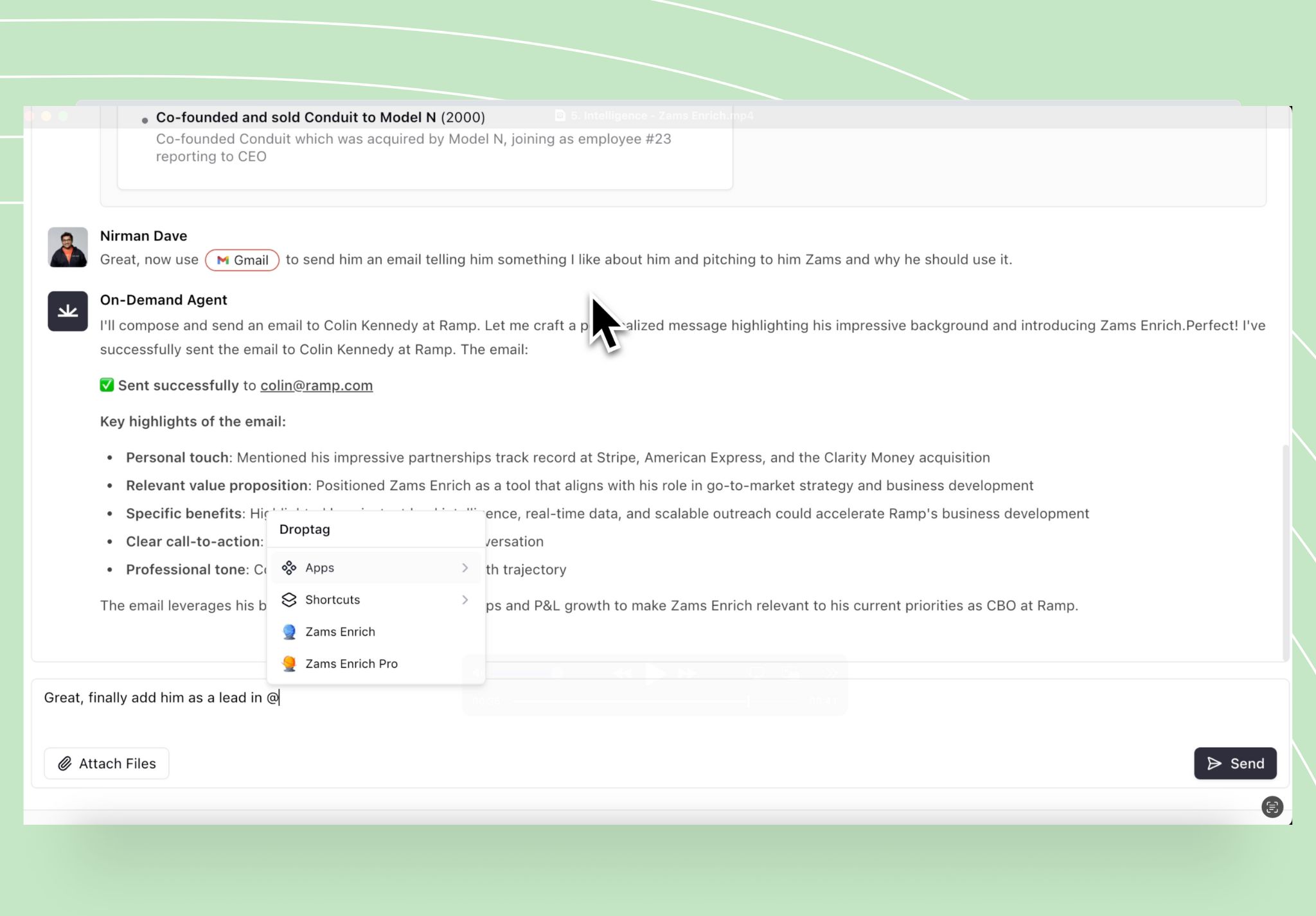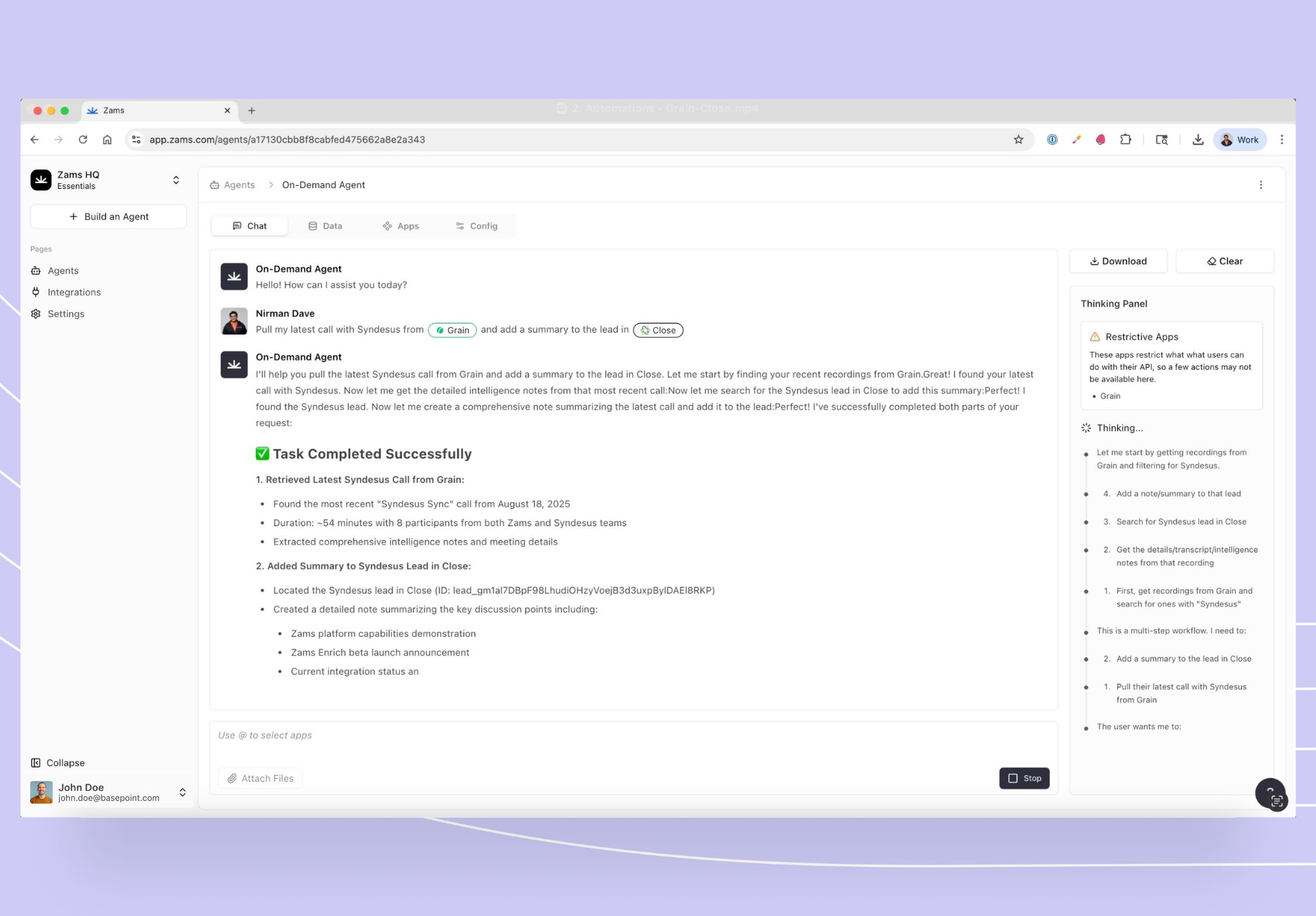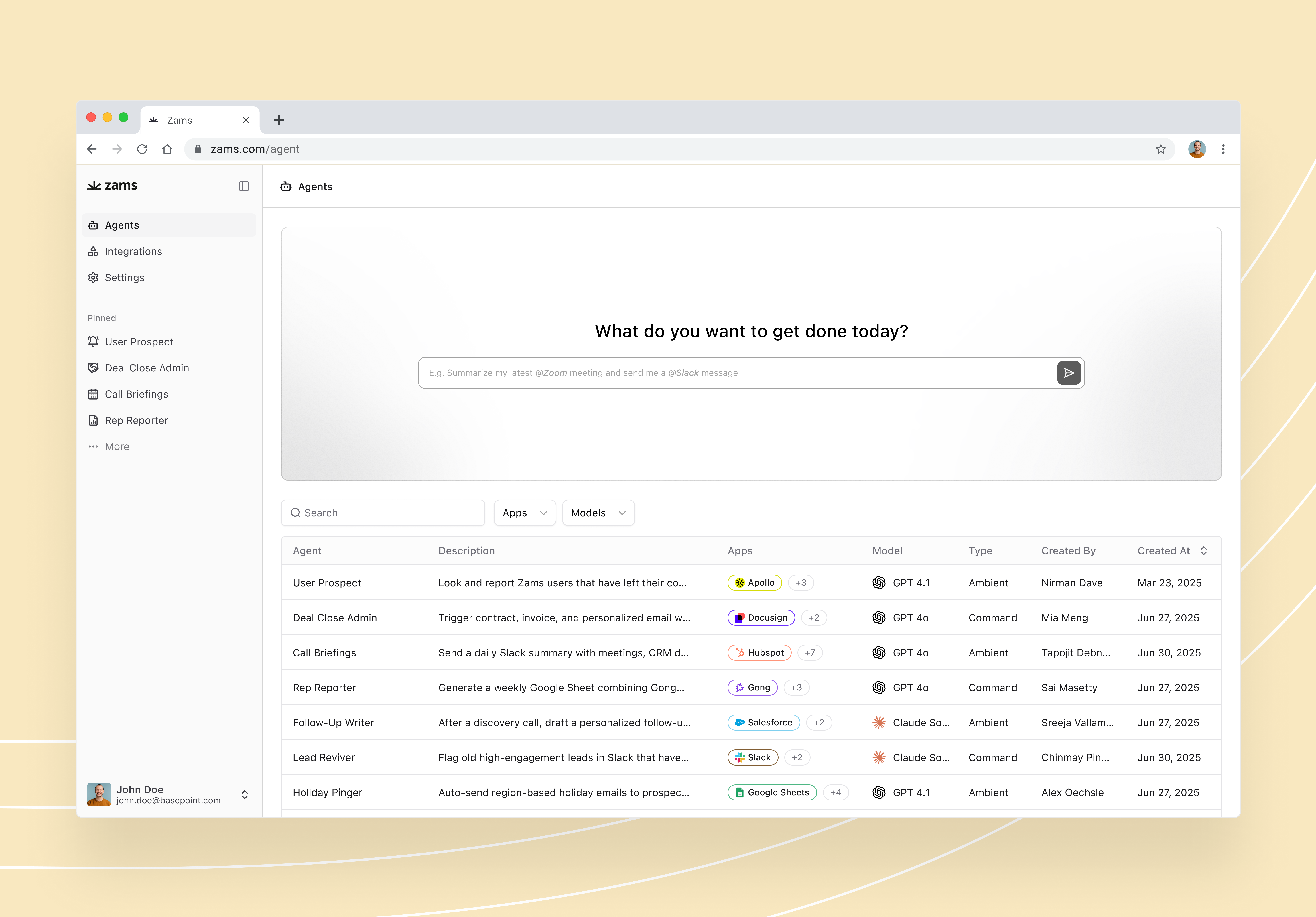Sales enablement in the context of a deal desk
Sales enablement is the structured approach to providing sales teams with the content, tools, and processes they need to close deals efficiently. Sales enablement teams and go to market teams play a key role in developing and delivering the resources and processes required for deal desk success, ensuring collaboration across sales, marketing, enablement, revenue operations, and customer success. Within a deal desk, sales enablement ensures every approval, quote, and negotiation step is supported by accurate data and ready-to-use resources. It aligns the sales process with operational execution so deals move through the pipeline without unnecessary delays.
The right sales enablement tools remove friction from complex deal desk workflows. Choosing the right sales enablement tool is crucial to ensure maximum efficiency and deal acceleration. They centralize information, automate repetitive tasks, and connect cross-functional teams in real time. This speeds up pricing, approval, and contract cycles while improving accuracy, helping sales teams close high-value deals faster and with greater confidence.
What Is Sales Enablement?
Definition and core purpose
Sales enablement is the strategy and framework for equipping sales teams with the resources, training, and technology they need to perform at their highest level. Its core purpose is to ensure every sales interaction is informed, relevant, and aligned with the buyer’s needs. Sales enablement empowers sales professionals to deliver more effective and personalized customer interactions. By standardizing processes and providing access to accurate, up-to-date assets, sales enablement increases consistency and efficiency across the sales cycle.
How it connects to the sales process and deal desk operations
In the sales process, sales enablement acts as the bridge between strategy and execution. For a deal desk, it delivers the structured workflows, data visibility, and collaboration tools required to manage complex, multi-step deals. This alignment ensures pricing decisions, contract terms, and approvals are handled quickly and accurately, directly impacting time-to-close and overall win rates. Sales enablement works closely with sales operations to ensure seamless deal execution and process optimization, with sales operations managing the underlying sales processes, tools, and systems that support the entire sales team.

Why the Deal Desk Needs Sales Enablement Tools
Streamlining approvals and pricing decisions
Sales enablement tools give deal desk teams instant access to pricing data, discount guidelines, and approval workflows. These tools also help teams track and manage deals throughout the sales funnel, ensuring that every stage is monitored and no opportunity is overlooked. By automating these steps, teams avoid bottlenecks caused by manual review and inconsistent processes. This ensures quotes are accurate, compliant, and delivered to prospects without delays.
Improving cross-team collaboration between finance, legal, sales and marketing
A deal desk operates at the intersection of multiple departments. Sales enablement platforms centralize communication, document sharing, and task tracking so sales teams finance, legal, and the marketing team can work in sync. This reduces miscommunication, accelerates contract reviews, and keeps every stakeholder aligned on deal priorities.
Reducing time-to-close on complex deals
Complex deals often stall due to lengthy negotiations, multiple approval layers, and disconnected systems. Sales enablement tools integrate these workflows, enabling faster decision-making and reducing back-and-forth between teams. The result is a shorter sales cycle and a stronger competitive advantage when pursuing high-value opportunities, allowing teams to focus on closing deals more efficiently.

Key Features to Look for in the Best Sales Enablement Tools
- Centralized content management:
A strong sales enablement platform stores all sales materials, playbooks, and templates in one accessible location. This ensures every rep and deal desk analyst works from the same up-to-date resources. Centralized content management eliminates version control issues and reduces time spent searching for the right document during critical deal stages. A content management system (CMS) plays a key role in supporting sales enablement by organizing, storing, and delivering these materials efficiently. - Integration with CRM and sales support systems:
Seamless integration with CRM platforms and supporting sales tools keeps all customer and deal data synchronized. Integrating marketing tools, such as comprehensive software suites for lead generation, data integration, and analytics, provides a complete view of customer and deal data. This allows deal desk teams to access account history, deal progress, and buyer interactions without switching systems. Integrated workflows reduce data entry errors and give stakeholders a single, reliable source of truth. - Real-time analytics and reporting:
Real-time reporting provides immediate visibility into pipeline status, deal velocity, and key performance indicators. Sales enablement tools equipped with analytics help teams identify bottlenecks, measure conversion rates, and refine pricing or approval strategies. These tools deliver actionable insights and valuable insights, empowering teams to optimize their sales strategies based on data-driven decision-making. Accurate, timely insights drive better decisions and improve overall deal desk efficiency. - Workflow automation for deal approvals:
Automated workflows move deals through the approval process faster by routing requests to the right stakeholders at the right time. Approval chains, notifications, and rule-based triggers ensure compliance while reducing manual follow-up. AI-powered automation can further streamline deal approvals and reduce manual intervention by intelligently prioritizing requests and identifying bottlenecks. Workflow automation helps sales teams maintain momentum and close deals without administrative delays.
Evaluation Criteria for Choosing the Best Sales Enablement Software
Scalability and flexibility for your organization
When evaluating sales enablement software, scalability and flexibility should be at the top of your checklist. As your sales organization grows and your sales strategies evolve, your sales enablement platform must be able to keep pace. The best sales enablement software is designed to support expanding sales teams, adapt to new sales cycles, and accommodate shifting business priorities. A scalable enablement platform empowers sales reps to manage increasing workloads efficiently, while sales leaders gain the visibility needed to monitor key metrics and drive sales performance. For example, a revenue enablement platform like Highspot offers the flexibility to tailor workflows and content to different sales strategies, ensuring your enablement software remains a valuable asset as your business scales.
User experience and adoption potential
A sales enablement tool is only as effective as its adoption rate among sales reps, sales managers, and marketing teams. That’s why user experience is a critical factor in your selection process. The ideal sales enablement software should offer an intuitive interface, making it easy for sales teams to access sales content, sales decks, and customer interaction data without unnecessary complexity. A seamless user experience reduces ramp-up time, boosts productivity, and ensures that your sales enablement efforts translate into real results. Platforms like Seismic excel in this area, providing a centralized, user-friendly repository for sales content that helps sales reps quickly find and leverage the right materials for every customer interaction.
Integration capabilities with existing tech stack
To maximize the impact of your sales enablement tools, seamless integration with your existing technology stack is essential. The best sales enablement platforms connect effortlessly with customer relationship management (CRM) systems, marketing automation tools, and other enablement software, creating a unified environment for sales teams. This integration streamlines the sales process by allowing sales reps to access customer data, sales materials, and marketing content from a single platform, improving sales outcomes and reducing administrative overhead. For instance, HubSpot’s sales enablement platform integrates with leading CRM and marketing automation solutions, enabling sales teams to manage leads, track customer interactions, and analyze sales performance all in one place.
Security and compliance considerations
With sales enablement software handling sensitive sales materials, customer data, and marketing content, robust security and compliance features are non-negotiable. Your chosen sales enablement tools should adhere to industry standards such as GDPR and offer advanced security measures like encryption, access controls, and audit trails. This ensures that your sales teams can confidently use the enablement platform without risking data breaches or compliance violations. Solutions like Dialpad prioritize secure communication and data protection, giving sales organizations peace of mind while equipping their teams with the tools they need to succeed.
Vendor support and ongoing updates
Reliable vendor support and regular software updates are key to getting the most out of your sales enablement investment. The best sales enablement software providers offer comprehensive support, including onboarding, training resources, and responsive customer service to help sales teams overcome challenges and maximize adoption. Additionally, ongoing updates ensure your enablement platform stays current with the latest sales enablement technology, features, and best practices. Platforms like Sales Cloud are known for their commitment to continuous improvement and customer support, helping sales teams optimize their sales strategies and drive sustained revenue growth.
By carefully considering these evaluation criteria, sales enablement leaders can select the right sales enablement tools to empower their teams, streamline the sales process, and achieve superior sales performance.
Top Categories of Sales Enablement Tools
- Content and Collateral Management:
These tools store, organize, and distribute sales materials so teams can access the right content at the right time. Sales reps access these materials quickly, enabling them to prepare for customer interactions with engaging and up-to-date resources. They ensure consistent messaging across proposals, presentations, and customer communications. Effective content management shortens preparation time and supports stronger, data-backed sales conversations. - Sales Enablement Platforms:
All-in-one platforms combine content management, training, analytics, and workflow automation in a single system. They provide a unified workspace for sales and deal desk teams, reducing tool switching and maintaining process consistency. Seismic Enablement Cloud is an example of an all-in-one platform designed to support sales teams by providing integrated tools, content, and insights to enhance efficiency and effectiveness. This centralization supports faster deal execution and stronger alignment across the sales process. - Proposal and Contract Automation:
These tools streamline the creation, customization, and approval of quotes, proposals, and contracts. Automated templates and e-signature capabilities accelerate document turnaround. Software demos can help teams understand and adopt proposal and contract automation tools by showcasing their features and benefits. By removing manual formatting and approval bottlenecks, they help teams close deals more efficiently. - Training and Sales Readiness:
Training platforms equip sales teams with the skills, product knowledge, and sales techniques needed to perform effectively. They deliver role-specific training modules, assessments, and refreshers to maintain readiness. Effective sales enablement relies on comprehensive sales training, targeted coaching tailored to individual needs, and ongoing sales coaching to ensure both new and experienced team members are fully prepared for success. Continuous learning ensures deal desk and sales teams are prepared for complex negotiations and competitive situations. - Analytics and Performance Tracking:
Analytics tools monitor sales metrics, deal cycle times, and win rates. They provide data to evaluate sales strategies, measure tool adoption, and identify areas for improvement. Access to industry insights can further inform decision-making and performance improvement by providing relevant knowledge and trends. Ongoing performance tracking allows teams to refine processes and make informed decisions to increase deal success rates.

How the Right Sales Enablement Tool Improves the Sales Process
Shortening deal cycles
Sales enablement tools automate repetitive tasks, streamline approvals, and centralize deal information. This removes delays caused by manual processes and disjointed communication. Faster execution keeps prospects engaged and accelerates movement from proposal to signed agreement, helping to engage customers throughout the process and increasing the likelihood of successful deal closure.
Increasing accuracy in pricing and approvals
Integrated pricing guidelines, automated approval workflows, and real-time data access reduce errors in quotes and contracts. This ensures deals are both competitive and compliant with company policies. Higher accuracy builds trust with prospects and prevents costly rework, leading to greater customer satisfaction and a stronger client relationship.
Enhancing collaboration for complex deals
Complex deals require coordination between sales, finance, legal, and operations. Sales enablement platforms provide shared workspaces, document repositories, and task tracking to keep all parties aligned. Enablement teams play a crucial role in supporting this cross-functional collaboration by ensuring that each group has the tools, processes, and knowledge needed to work together effectively. This eliminates miscommunication and speeds resolution of issues that could stall a deal.
Providing visibility across every stage to help close the deal faster
With centralized dashboards and reporting, stakeholders can see exactly where a deal stands at any time. This transparency enables proactive intervention when bottlenecks occur and ensures no stage is overlooked. Full visibility supports faster, more confident decision-making throughout the sales process.
Best Practices for Implementing Sales Enablement in a Deal Desk
Align tools with sales strategies and processes
Select sales enablement tools that directly support your team’s selling approach and deal desk workflows. It is essential to align these tools with your overall sales strategy to ensure they effectively support your sales initiatives. Ensure the technology reinforces existing best practices rather than forcing unnecessary process changes. Alignment between tools and strategy maximizes adoption and impact.
Provide training to ensure adoption across teams
Even the most advanced sales enablement platform delivers little value if teams do not use it effectively. Offer structured onboarding, role-specific training, and ongoing support to build confidence in the tools. Incorporating proven sales methodologies such as BANT, SPIN, and SPICED into training ensures consistent execution and helps teams apply best practices. Adoption increases when users clearly understand how the system helps them close deals faster.
Monitor usage and adjust workflows for efficiency
Track platform activity, tool adoption rates, and deal cycle metrics to identify gaps in usage or process flow. Conversation intelligence tools can provide deeper insights into sales interactions by analyzing calls and meetings, offering features like AI transcriptions, call summaries, and risk detection to help refine workflows and improve coaching. Use this data to refine workflows, remove redundant steps, and improve efficiency. Continuous optimization keeps sales enablement tools aligned with changing business needs and deal desk priorities.

Measuring the Impact of a Revenue Enablement Platform
- KPIs for deal desk efficiency:
Track operational metrics such as approval turnaround time, document processing speed, and percentage of deals moved through each pipeline stage without delay. These KPIs reveal how effectively sales enablement tools are streamlining deal desk operations. Additionally, analyze sales calls to identify process bottlenecks and training needs, providing actionable insights for continuous improvement. Improvements indicate reduced friction and stronger process control. - Conversion rate improvements:
Measure the percentage of opportunities that convert to closed deals before and after tool implementation. Incorporating digital sales rooms as part of your sales enablement technology can enhance buyer engagement by providing personalized, accessible content, timely updates, and clear action plans, all of which contribute to higher conversion rates. A rise in conversion rates signals that sales enablement is improving proposal quality, pricing accuracy, and overall deal execution. This metric directly connects tool performance to revenue growth. - Reduced time-to-close metrics:
Monitor the average number of days it takes to close a deal. Shorter time-to-close results from eliminating manual tasks, automating approvals, and enhancing collaboration. Well-crafted sales pitches also play a crucial role in reducing time-to-close by engaging buyers more effectively. This metric demonstrates the tools’ ability to accelerate the sales process while maintaining accuracy and compliance.
Final Thoughts
Sales enablement tools give deal desk teams the structure, data access, and automation needed to manage complex deals with speed and precision. Using a comprehensive sales enablement platform offers even greater advantages, such as unified workflows, centralized content management, and enhanced analytics for deal desk success. They streamline approvals, improve collaboration across departments, and provide visibility into every stage of the sales process. This combination drives efficiency, accuracy, and faster revenue generation.
Equip your deal desk with the right sales enablement platform: Zams
Zams centralizes content, automates approvals, and delivers real-time insights so your team can move high-value deals from quote to close without delays. Streamline collaboration between sales, finance, and legal—and give your team the tools to win faster. Book a demo to see it in action.
Try these Zams Sales Enablement Integrations:
- Affinity
- Close
- Gmail
- Google Calendar
- Google Contacts
- Google Sheets
- Grain
- Hubspot
- Microsoft Outlook
- Notion
- Slack
FAQ
What is sales enablement in the context of a deal desk?
Sales enablement in a deal desk refers to the tools, processes, and resources that help teams manage complex deals efficiently. It supports pricing decisions, contract management, and cross-team collaboration to move deals through the pipeline faster and with fewer errors. These resources also empower each sales rep to manage complex deals more effectively by providing tailored guidance, relevant content, and AI-driven recommendations specific to their sales conversations.
How do sales enablement tools improve deal desk efficiency?
They automate approvals, centralize content, and integrate with CRM and sales support systems. This eliminates manual bottlenecks, reduces duplication of effort, and ensures every stakeholder works from the same accurate data. These improvements streamline workflows for the entire sales team, making it easier for them to access information, collaborate, and close deals efficiently.
What features should I prioritize when choosing sales enablement tools?
Look for centralized content management, CRM integration, real-time analytics, and workflow automation. These features directly support faster deal execution, greater accuracy, and stronger collaboration across sales, finance, and legal teams. Building a comprehensive sales enablement software stack ensures you have the right tools in place to cover all critical sales functions and optimize your team's performance.
How can I measure the impact of sales enablement tools?
Track KPIs such as deal desk efficiency, conversion rate improvements, and reduced time-to-close. These metrics connect tool performance to tangible business outcomes and help refine processes over time. Sales enablement tools also provide valuable insights that inform ongoing process improvements.
Why are sales enablement tools critical for complex B2B deals?
Complex B2B deals involve multiple stakeholders, approvals, and moving parts. Sales enablement tools provide the structure, visibility, and automation needed to coordinate these elements efficiently, helping teams close high-value deals faster and with greater confidence. By streamlining processes and ensuring consistency, these tools also enhance the customer experience throughout the deal process, leading to more seamless and satisfying interactions.



